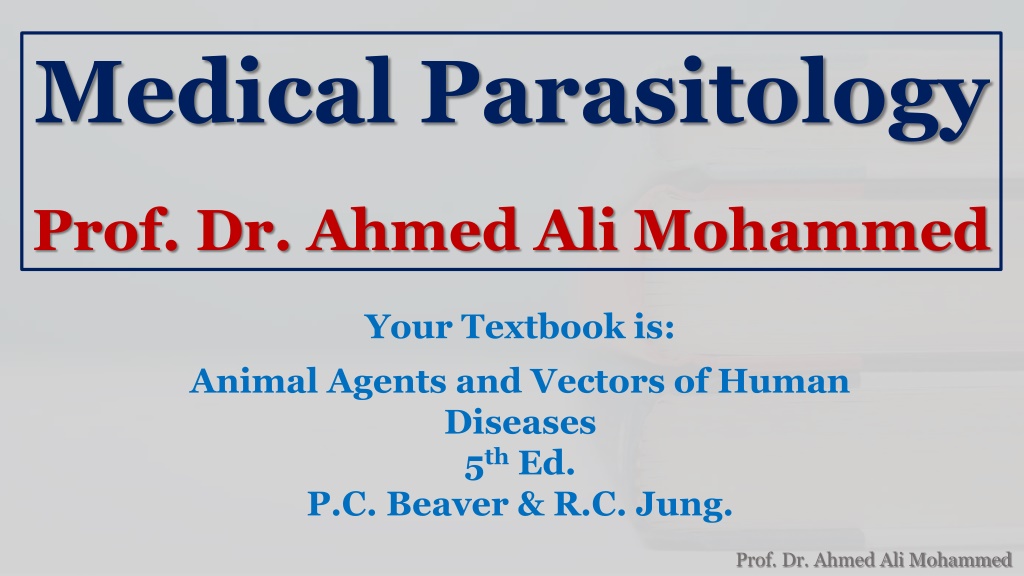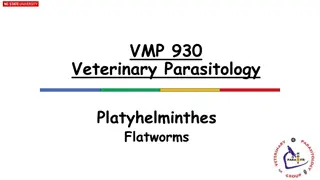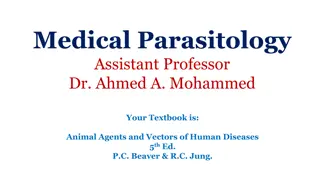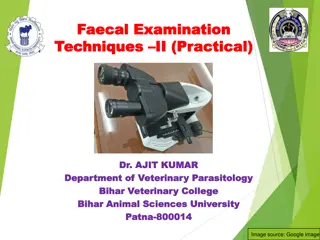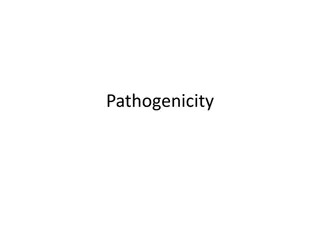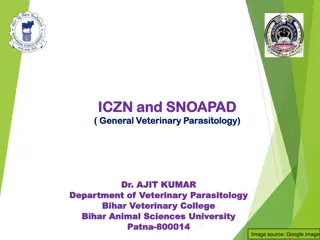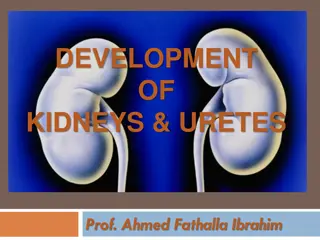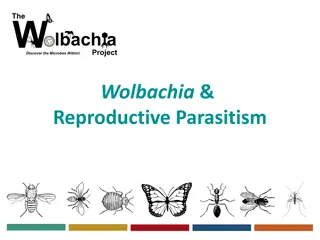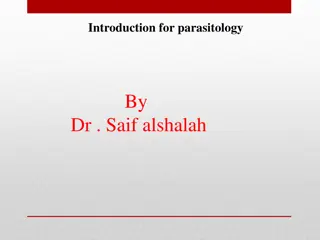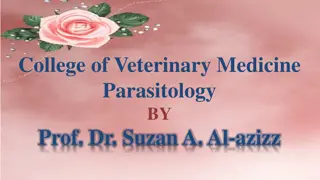Understanding Parasitism in Medical Parasitology by Prof. Dr. Ahmed Ali Mohammed
Prof. Dr. Ahmed Ali Mohammed delves into the intriguing world of parasitism, exploring the complex relationships between parasites and hosts. He explains the various types of relationships in parasitology, such as symbiosis, mutualism, commensalism, and parasitism, shedding light on how parasites interact with their hosts. Different types of parasites, including pathogenic parasites, commensals, ectoparasites, and obligate parasites, are discussed, along with their impacts on host organisms. The importance of achieving a delicate balance in parasite-host relationships is highlighted, emphasizing the fascinating evolutionary adaptations that have occurred among parasitic organisms over millennia.
- Parasitism
- Medical Parasitology
- Prof. Dr. Ahmed Ali Mohammed
- Host-Parasite Interactions
- Pathogenic Parasites
Download Presentation

Please find below an Image/Link to download the presentation.
The content on the website is provided AS IS for your information and personal use only. It may not be sold, licensed, or shared on other websites without obtaining consent from the author. Download presentation by click this link. If you encounter any issues during the download, it is possible that the publisher has removed the file from their server.
E N D
Presentation Transcript
Medical Parasitology Prof. Dr. Ahmed Ali Mohammed Your Textbook is: Animal Agents and Vectors of Human Diseases 5th Ed. P.C. Beaver & R.C. Jung. Prof. Dr. Ahmed Ali Mohammed
Lecture 1 Introduction and Definitions Prof. Dr. Ahmed Ali Mohammed
Introduction Among the evolutionary processes that have been underway for countless millennia, perhaps the most interesting is the adaptation to the parasitic mode of life. Many examples found among the groups of lower organisms, such as viruses, rickettsiae, bacteria, fungi and spirochetes. However, the more interesting is the evolutionary changes that happened to the parasites belonging to the animal kingdom, because they have originated from so many phylogenetic stems. Parasitism varies widely with respect to the degree of adaptation, including morphologic simplification and physiologic readjustments that have resulted from dependant relationships. Prof. Dr. Ahmed Ali Mohammed
Types of relationships Symbiosis: Is the relationship between two dissimilar organisms adapted for living together, and the associates called symbionts. This association may be beneficial or harmful to either of the associates. Mutualism: Is termed tosymbiotic association that is beneficial to both parties. Commensalism: Is the relationship between two organisms where one of the associated organisms is benefited and the other is neither benefited nor harmed. Parasitism: Is the relationship of two organisms where one of them (the parasite) lives in or on the other at the expense of the latter which called the host. The parasite: Is the organism which depends on other living organism in its feeding, housing and transportation, which called the host. The host may either not be harmed or may suffer the consequences of this association, which represents the parasitic disease. Prof. Dr. Ahmed Ali Mohammed
*Parasitism possibly suggests that the parasite is harmful to its host, but the successful parasite should reach a precise equilibrium with its host so that each tolerates the other. If the balance is disturbed, the host may spontaneously expel or destroy the parasite, or, on the other side, the association may become so harmful to the host which lead to the infection and the parasite deposit as a consequence. Types of Parasites Parasites that cause harm to the host called pathogenicparasites while those that benefit from the host without causing any harm to their hosts known as commensals. Ectoparasites: Areorganisms live on or in the skin of their hosts, this relationship called infestation. Most parasitic arthropods belong to this category. Endoparasites: Are the parasites of the digestive tract, extraintestinal organs and tissues, and those that are intracellular within the host, and produce infection, irrespective of their size. Obligateparasites: are the parasites that are entirely dependent on their hosts. Facultative parasites: arecapable of living either free or in or on a hosts. Prof. Dr. Ahmed Ali Mohammed
Types of Parasites According to the nature of the host-parasite interactions and the environmental factors, the parasite may be one of the following types: 1. The obligatory parasite: it is completely dependent on its host and can t survive without it, e.g. hookworms. 2. The facultative parasite: is the parasite that can change its lifestyle between free- living in the environment and parasitic according to the surrounding conditions, e.g. Strongyloides stercoralis. 3. The accidental parasite: is that affects an unusual host, e.g. Toxocara canis (a dog parasite) in man and the metacestode (larval hydatid cyst) of Echinococcusgranulosus. 4. The temporary parasite: is the parasite that visits the host only for feeding and then leaves it, e.g. Bed bug visiting man for a blood meal. Prof. Dr. Ahmed Ali Mohammed
5. The permanent parasite: is that one that lives in or on its host without leaving it, e.g. Lice. 6. The opportunistic parasite: is the parasite that can produce disease in an immunodeficient host (like AIDS and cancer patients). Whereas in the immunocompetent host, it is either found in a latent form or causes a self-limiting disease, e.g. Toxoplasma gondii. 7. The zoonotic parasite: is that primarily infects animals and is transmittable to humans, e.g. Fasciola species. 8. The erratic parasite: is one that found in an organ in which it is not usually found, e.g. Entamoeba histolytica in the liver or lung of humans. 9. The host-specific parasite: is the parasite that have become dependent on a single species of host, e.g. Malaria parasites of the human, and human Schistosomes. Prof. Dr. Ahmed Ali Mohammed
The most acceptable taxonomic classification of human parasites includes Endoparasites and Ectoparasites. Endoparasites are sub-classified into Protozoan parasites (unicellular organisms) and Helminthic parasites (multicellular organisms). Helminthic parasites are either flat worms (Trematodes), segmented tape like worms (Cestodes) or cylindrical worms (Nematodes or round worms). Endoparasites Most human s parasites live inside the body. These are helminths (worms of various types), protozoa, or sometimes larval stages of arthropods (insects, mites, etc.). Both helminthic and protozoan parasites can infect different tissues and organs of the human body. A great number of endoparasites lives in the intestines, or at least passes through the intestines, having been swallowed in food or water. Prof. Dr. Ahmed Ali Mohammed
Practically,any organ can be affected, however some parasites are targeting certain organs in the body like Trichinella spp. and Toxoplasma gondii which live in the muscles, the larvae of Echinococcus spp. and the liver flukes which occupy the liver, Schistosomahaematobium targets the urinary bladder. Ectoparasites Human ectoparasites live on the host. They include the fleas, lice, mosquitoes, flies, bugs, mites, ticks etc. In general, ectoparasites attach to the skin to feed and do not remain on the host for their entire lives. Some of these organisms lie in a grey area between endoparasites and ectoparasites. Scabies mites, for example, are generally considered ectoparasites although the female mite hide into the skin. Prof. Dr. Ahmed Ali Mohammed
Types of Hosts Definitive (or final) host: is an organism in which the adult or final stage of a parasite develops. Intermediate host: is the host in which an intermediate or larval stage of the parasite develops. Paratenichost: is the host in which the parasite is transported and neither gains nor loses infectivity for its definitive host. Vectors: are transmitters of parasites from host to host. If this transmitter is not essential to the life cycle, it is a mechanical vector; if it is essential, it is a biological vector. Reservoir host: is an animal species on which the parasite depends for its survival in nature and serves as a source of infection for other susceptible host, including man. Zoonosis: is the term applied to a disease of animals when it is transmitted to man; this may be a common or an incidental occurrence. *The parasites have developed physiologic and biochemical adaptations needed for its new associations. The continued existence of a parasite as a species is dependent on adaptations for reaching and entering its host as well as maintenance of its position within the host once it has arrived. From the above, it can define Parasitology asthe science which studies the parasites from all its life aspects. Prof. Dr. Ahmed Ali Mohammed
Medical Parasitology Parasitology is a dynamic field because the relationships between the parasites and their hosts are constantly changing. Parasites are often causing important diseases to humans and animals. Consequently, the host suffers from various illnesses, infections and discomforts. However, in some cases, the host may show no signs of infection at all. Parasitic diseases may be presented by a wide variety of clinical manifestations depending on the invaded tissue or part in the host body. Medically important parasites affect billions of people, kill millions annually and causes massive injuries such as blindness and disfiguration on additional millions. Prof. Dr. Ahmed Ali Mohammed
Several aspects concerning these parasites are highlighted in the study of Medical Parasitology such as: -their classification -general characteristics -their biology -the ecological (environmental) factors that affect their transmission -the immune response of the host body to these parasites, as well as -the diagnosis and the control of the diseases that developed by these parasites. Therefore, it is briefly the branch of medical sciences dealing with the parasites which live temporarily or permanently, on or within the human body (the host). Prof. Dr. Ahmed Ali Mohammed
Parasitic infections, Pathogenesis and immunity: *Parasitic infections are associated with a broad spectrum of effects. Some are due to the parasites themselves and others are a consequence of the host response to the invader. *The nature and extent of the pathological effects are dependent upon the site and mode of infection and also on the level of the parasite burden. *The development of protective immunity to such parasites is more complicated than that to bacteria and viruses because of the complicated life cycles of the parasites. *As with other infectious agents, the site occupied by a parasite is important. For instance, a host will survive with a large number of lung flukes (Paragonimusspp.) in the lungs, but infection in the brain may cause far more serious effects. *The severity of disease depends not only on the degree of the infection but also on the physiological status of the host. A lowering of general health, due to malnutrition for example, predisposes to more serious consequences following infection by parasites. *The physical obstruction of anatomical sites leading to loss of function can be a major component of the diseases caused by the parasites. The intestinal lumen can be blocked by worms such as Ascaris lumbricoides or tapeworms, and filarial parasites (Wuchereriabancrofti and Brugia malayi) can obstruct the flow of lymph through lymphatics. Prof. Dr. Ahmed Ali Mohammed
*Intestinal infection with the tapeworm Taenia solium is usually of little consequence, but the eggs may develop into larvae (cysticerci) in humans, causing cysticercosis. The cysticerci can be found in the muscle, liver, eye or, most dangerously, the brain. Hydatid cysts, the larval stage of the dog tapeworm (Echinococcus granulosus) in man, may reach volumes of 1 2 L, and such masses can cause severe damage to an infected organ. *Another type of pathogenicity may be represented by the physiologicaleffects. The large numbers of Giardia spp. covering the walls of the small intestine can lead to malabsorption, especially of fats and fat- soluble vitamins. *Competition by parasites for essential nutrients leads to host deprivation. Thus, depletion of vitamin B12 by the tapeworm Diphyllobothrium latumsometimes leads to pernicious anaemia. *Immunoparasitology: is the branch of immunology that deals with the human parasites and their hosts immune response. Immunopathology: Many helminth parasites are long-lived and causes chronic infections. The immune response that develops during this time often proceeds to cause pathologic changes that in many helminth infections are the primary cause of disease. A well-studied example of this is the granulomatous reaction that isolate schistosome eggs, and the fibrous layer that isolate the hydatid cyst of Echinococcus. Prof. Dr. Ahmed Ali Mohammed
Immune responses that prevent infection with helminths: A prevalent theme of resistance to helminths is that of premunition or concomitantimmunity, a state wherein the host is protected from further infection with a given species by ongoing persistent infection with the same organism. There are at least two explanations for this type of immunity. 1. In one scenario, parasites of the primary infection induce an immune response that, while incapable of killing them, is nevertheless able to kill incoming parasites that may cause a superinfection. 2. A second explanation is that the primary infection alters the anatomy or physiology of the host in such a way that it becomes more difficult for incoming larval organisms to establish infection in the appropriate niche. *Killing of helminths by eosinophils via antibody-dependent cellular cytotoxicity (ADCC) is an attractive and widely cited mechanism for resistance to parasitic worms. Prof. Dr. Ahmed Ali Mohammed
Immune evasion: They are different mechanisms used by the parasites to escape the cytotoxic effects of the host immune response by mimic the host structural molecules to disguise the immune system of the host and prevent the recognition of their antigens. For example, numerous parasites modulating their surface structure or antigens in a way that prevents their recognition, or expressing materials similar to that of the host like the transforming growth factor (TGF), or producing receptors for the host products and materials and use them instead of the host target cells. The long-term survival of helminth parasites within mammalian hosts indicates that they have developed sophisticated mechanisms to escape the cytotoxic effects of the host immune response. Prominent among these the expression of the transforming growth factor receptor family members by helminths, and, in the case of nematodes at least, a homologue of transforming growth factor itself. Vaccine development: The application of antihelminth vaccines is more advanced in veterinary medicine than in human medicine, with a history of the use of attenuated vaccines against certain nematode parasites and more recently the development of recombinant protein and DNA vaccines against the sheep tapeworm Taenia ovis. Prof. Dr. Ahmed Ali Mohammed
Symptoms Are the manifestations of the pathological processes resulted from the effects of the agent. *In some parasitosis the host may be essentially unresponsive. *In other instances, the host may generate specific antibodies that counteract the antigens introduced by the foreign agent, or may wall off the invader or its products by cellular infiltration, proliferation and differentiation. *The host response may be essentially local at the site of injury, or it may include system humoral or cellular changes. *A person may carry a parasitic infection that is transmissible to others, yet himself show no related signs or symptoms. This person is called a carrier. Effects of the parasites on the hosts Parasites trigger varying degrees of change within their hosts. Although not definitive, the disease often results. Small numbers of parasites often elicit no clinical symptoms. However, several factors commonly influence the onset of recognizable disease symptoms. Among these: 1. The number of parasites. 2. The species (or strain) of the parasite. 3. The physiological condition of the host. Prof. Dr. Ahmed Ali Mohammed
*Generally, parasites that injure their hosts called pathogenic or pathogens, while the development of this damage called pathogenesis. The degree of injury to the host depends on variety of factors, including: 1. The potential virulence of the agent (its essential pathogenicity). 2. The amount of inoculum. 3. The rapidity with which it may multiply in host tissues. 4. The site of inoculation. 5. The type of exposure, whether it is single or repeated exposure. 6. The tolerance or resistance of the host to the particular strain of the agent, and the general threshold of resistance of the host. The type of damage caused by the parasites: The damage produced by the parasite may be primarily: 1. Mechanical. 2. Lytic (enzymatic). 3. Toxic. 4. Allergic in nature. 5. The lesion produced by the parasite may open a way for the bacteria and other pathogens to enter the tissue. Prof. Dr. Ahmed Ali Mohammed
There are several conditions most often develop in parasitic diseases: A- Tissue Damage Three major types of histopathological cell damage occur in parasite-injured tissues: 1. Parenchymatous or Albuminous Degeneration This type of damage is characterized by swollen cells packed with albuminous or fatty granules, indistinct nuclei, and pale cytoplasm. It is often seen in the infected liver, cardiac muscle and kidney cells. 2. Fatty Degeneration This type of degeneration results in the deposition of abnormal amounts of fat in cells. This type of degeneration imparts a yellowish color to the cells and is common among parasite-laden liver cells. 3. Necrosis Persistent cell degeneration of any type causes death of cells or tissues. The dead cells give tissues an opaque appearance. For example, encystment and calcification of Trichinellaspiralislarvae in mammalian skeletal muscle cells andthe hydatid cyst of Echinococcus granulosuscauses necrosis of surrounding tissue. Prof. Dr. Ahmed Ali Mohammed
B- Tissue Changes Cell and tissue parasites sometimes evoke changes in the growth pattern of the affected tissue. Some of these changes are very harmful; others are merely structural with no serious systemic consequences to the host organism. These tissue changes of parasitic origin are of four major types: 1. Hyperplasia Elevation of the metabolic rate of cells causes cell proliferation by accelerating cell division. This condition, when associated with parasitism, is precipitated by the marked increase in host body repair activity that commonly follows inflammation. For example, inflammation caused by the liver fluke Fasciola hepatica stimulates excessive division of epithelial cells lining the bile duct, resulting in thickening of the duct wall. 2. Hypertrophy An increase in cell or organ size in victims of parasitic diseases. It is usually due to engorgement by intracellular parasites. For example, during the erythrocytic phase in the life cycle of the malaria- producing organism Plasmodium vivax, the parasitized red blood cells and the spleen commonly become enlarged. Prof. Dr. Ahmed Ali Mohammed
3. Metaplasia One type of tissue may be converted into another without the intervention of embryonic tissue. In patients infected with the lung fluke Paragonimus westermani, the parasite is surrounded by a host capsule consisting of cells, in this case, fibrocytes transformed from other types of cells. Similar changes are also happening intheinfection with the hydatid cyst of Echinococcus granulosus. 4. Neoplasia Abnormal cell growth may occur in a tissue, producing an entirely new entity, such as a tumor. The neoplastic tumor is not inflammatory, is not required for the repair of organs and does not conform to the normal growth pattern. Neoplasms may be benign (i.e., may remain localized with no invasion of adjacent tissues) or malignant (i.e., may invade adjacent tissues) or spread (metastasize) to other parts of the body through the blood or lymph. The human blood fluke Schistosoma haematobium is sometimes associated with malignant neoplasia of the urinary bladder. Prof. Dr. Ahmed Ali Mohammed
Diagnosis of Parasitic diseases Diagnosis of parasitic diseases depends on several laboratory methods like direct microscopy, imaging techniques, endoscopy and many other developed techniques, as well as the clinical picture and geographic location. Diagnosis using direct microscopy is based on detecting the parasite by the examination of different specimens such as the stool, urine, blood, CSF and tissue biopsies. Whereas immunodiagnostic techniques are depending on antigenand antibody-detection assays. In addition, molecular-based diagnostic approaches offer a great sensitivity and specificity, and recently, the nanotechnology can also be applied as diagnostic procedures utilizing nanodevices. The detection of enteric protozoa is a commonly requested test, particularly with increasing travel to and migration from endemic countries. Unfortunately, microscopy is slow and labor intensive and requires a high level of technical expertise. It also lacks both sensitivity and specificity, but recently developed nucleic acid amplification tests are automated and rapid and show superior accuracy. Additionally, proteomics shows promise for both the diagnosis of infections where parasite detection is difficult, and the potential for accurate assessment of cure in these cases. Prof. Dr. Ahmed Ali Mohammed
Epidemiology: It is the science concerned with the factors that determine the prevalence of infection and the incidence of a disease. It is the history of the disease, including infection in man and animals and agents that serve as reservoirs and vectors. *Infections maintained at a more or less stable rate of prevalence within the human population of an area are said to be endemic. *If there is a high prevalence, it is hyperendemic. Prevalence: Representing the number of infected individuals at a given time in a designated area. Incidence: Is the rate or frequency of disease (or new infection) occurring. *If the infection appears irregularly in scattered individuals, it is called sporadic; and if it develops a high prevalence through unusually rapid transmission, it is called epidemic. Prof. Dr. Ahmed Ali Mohammed
